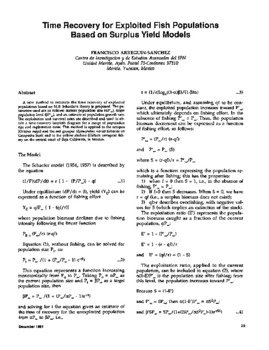Please use this identifier to cite or link to this item:
https://hdl.handle.net/20.500.12348/3102
Time recovery for exploited fish populations based on surplus yield models
| dc.creator | Arreguin-Sanchez, F. | |
| dc.date.accessioned | 2019-04-02T02:42:05Z | |
| dc.date.available | 2019-04-02T02:42:05Z | |
| dc.date.issued | 1991 | |
| dc.identifier | FB_2988.pdf | |
| dc.identifier.citation | Fishbyte 9(2): 39-41 | |
| dc.identifier.uri | https://hdl.handle.net/20.500.12348/3102 | |
| dc.description.abstract | A new method to estimate the time recovery of exploited population based on M.B. Schaefer's theory is proposed. The parameters used as follows: current population size (alphaP sub( infinity )'), target population level (BetaP sub( infinity )'), and an estimate of population growth rate. The exploitation and survival rates are described and used to obtain a time-recovery isopleth diagram for a range of population size and exploitation rates. This method is applied to the octopus (Octopus maya) and the red grouper (Epinephelus morio) fisheries on Campeche Bank and to the yellow abalone (Haliotis corrugata) fishery on the central coast of Baja California, in Mexico. | |
| dc.format | application/pdf | |
| dc.language | En | |
| dc.publisher | ICLARM | |
| dc.rights | CC BY 4.0 | |
| dc.source | Fishbyte | |
| dc.title | Time recovery for exploited fish populations based on surplus yield models | |
| dc.type | Journal Article | |
| dcterms.bibliographicCitation | Arreguin-Sanchez, F. (1991). Time recovery for exploited fish populations based on surplus yield models. Fishbyte 9(2): 39-41 | |
| cg.coverage.country | Mexico | |
| cg.identifier.worldfish | 2988 | |
| cg.subject.agrovoc | fish | |
| cg.subject.agrovoc | research | |
| cg.contributor.affiliation | Centro de Investigacion y de Estudios Avanzados del IPN | |
| cg.identifier.status | Open access | |
| cg.description.theme | Sustainable aquaculture | |
| worldfish.location.area | Latin America |
Files in this item
This item appears in the following Collection(s)
-
Sustainable aquaculture [2735]
